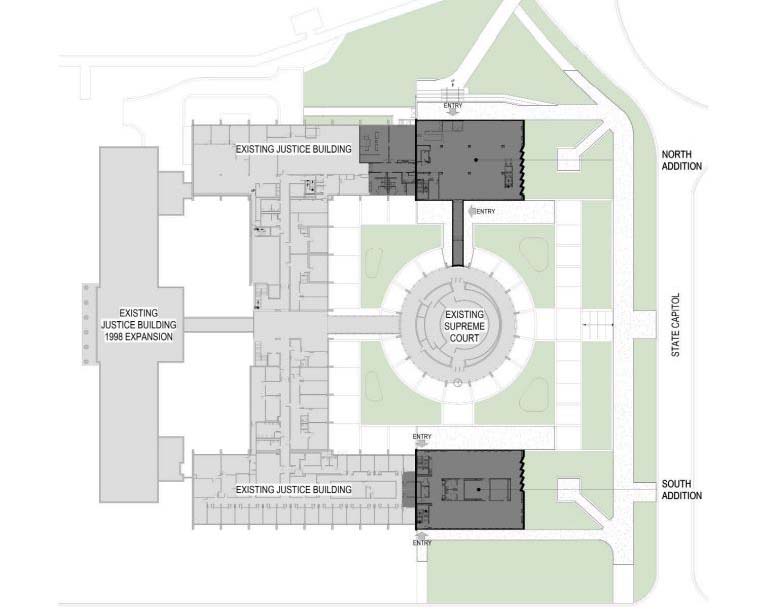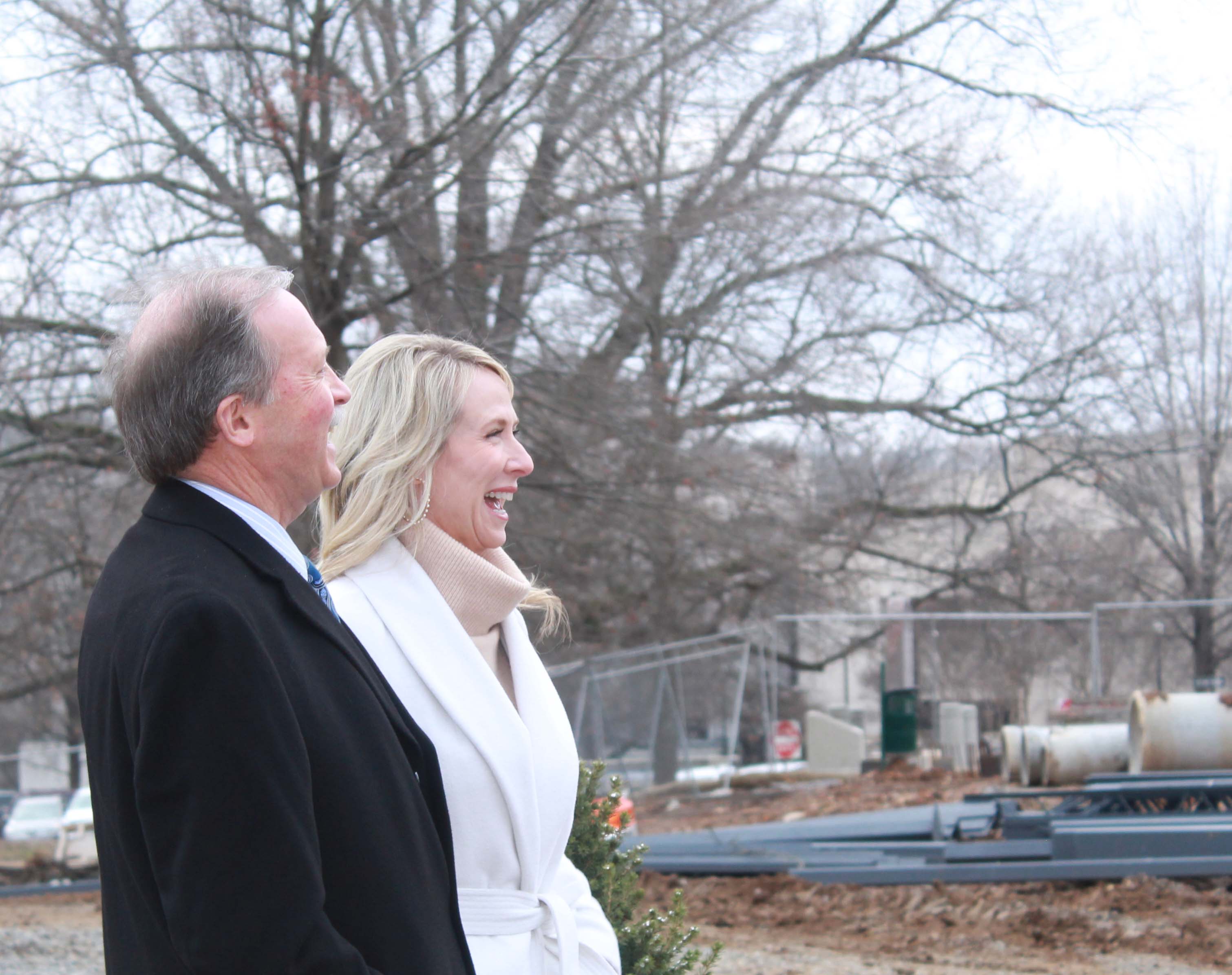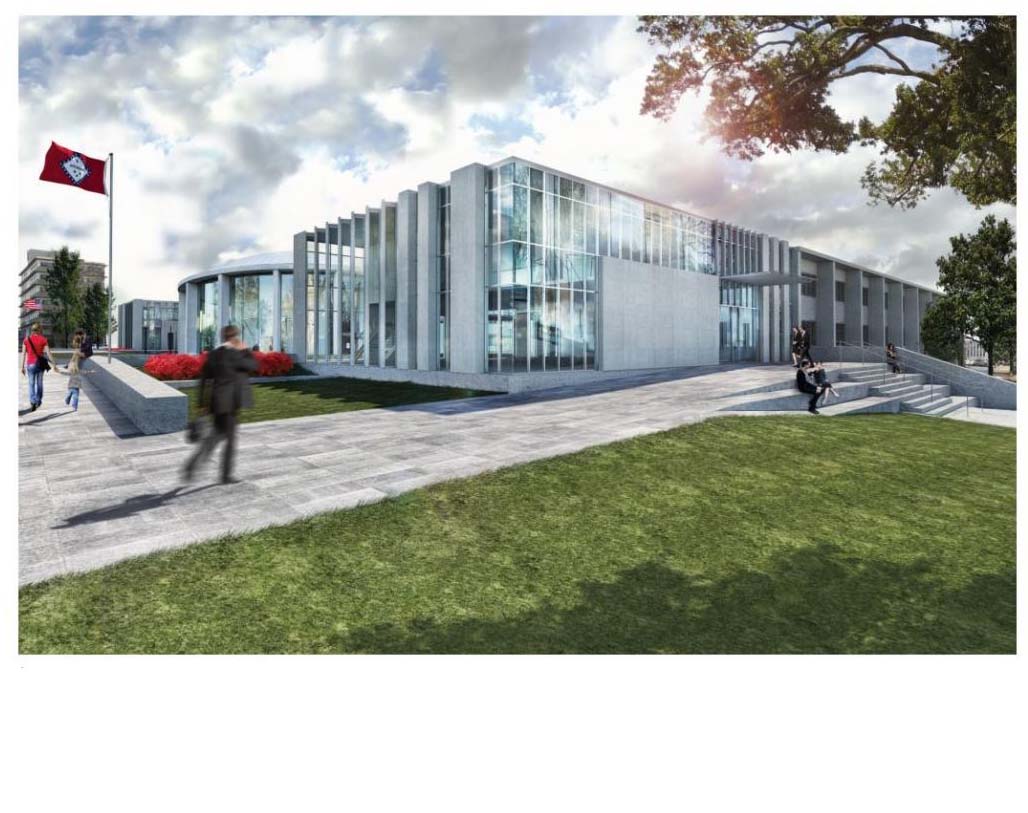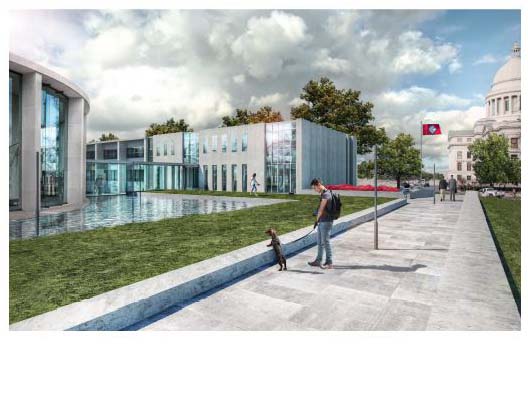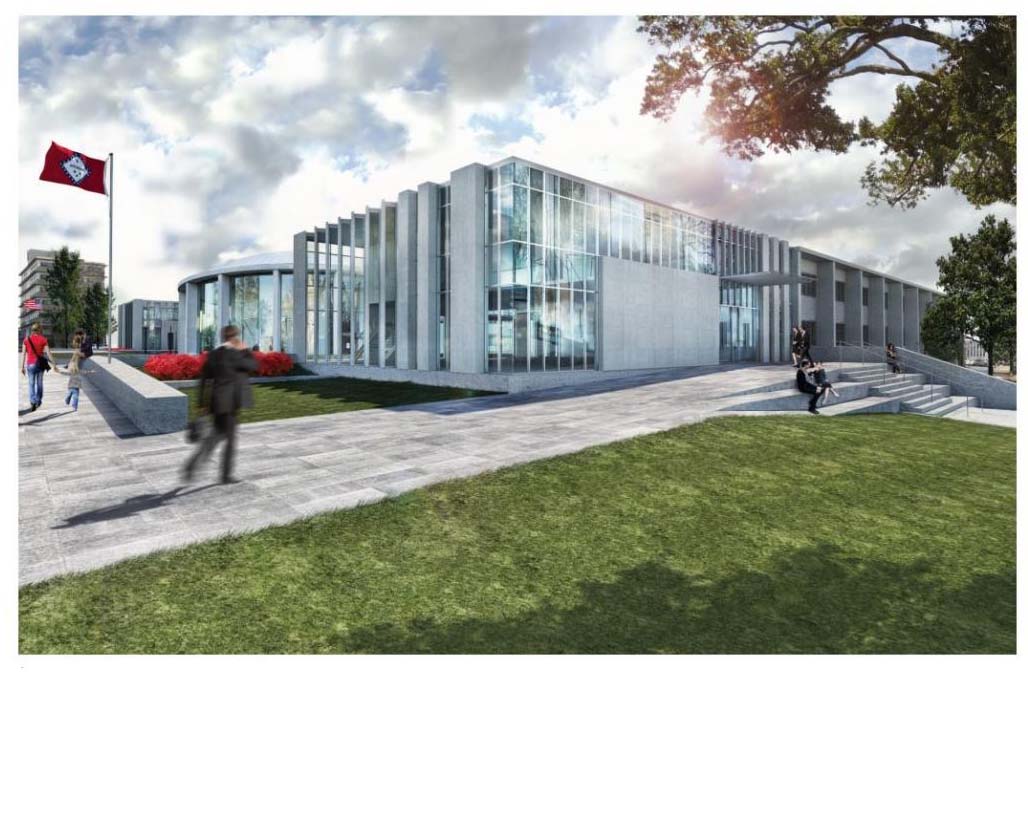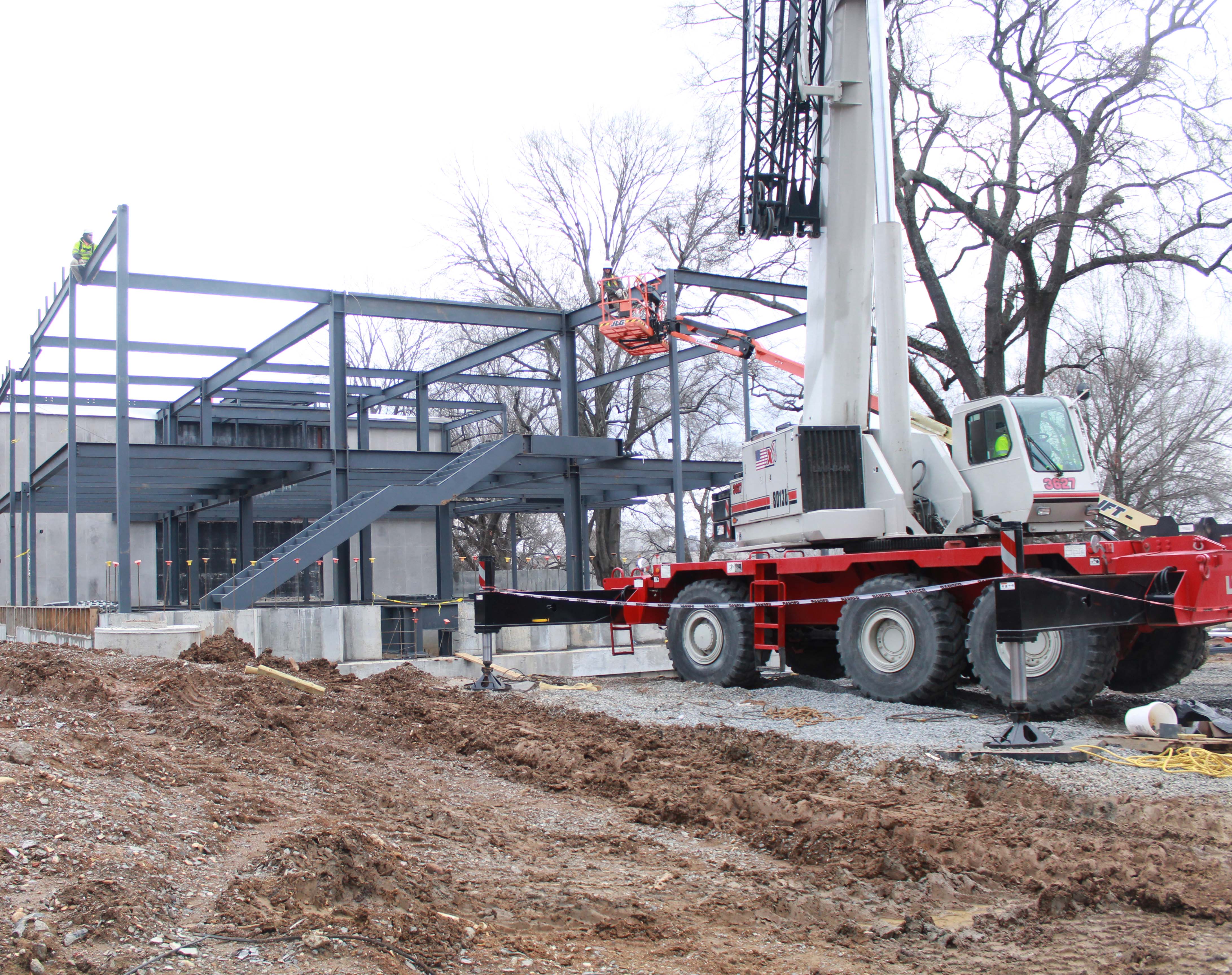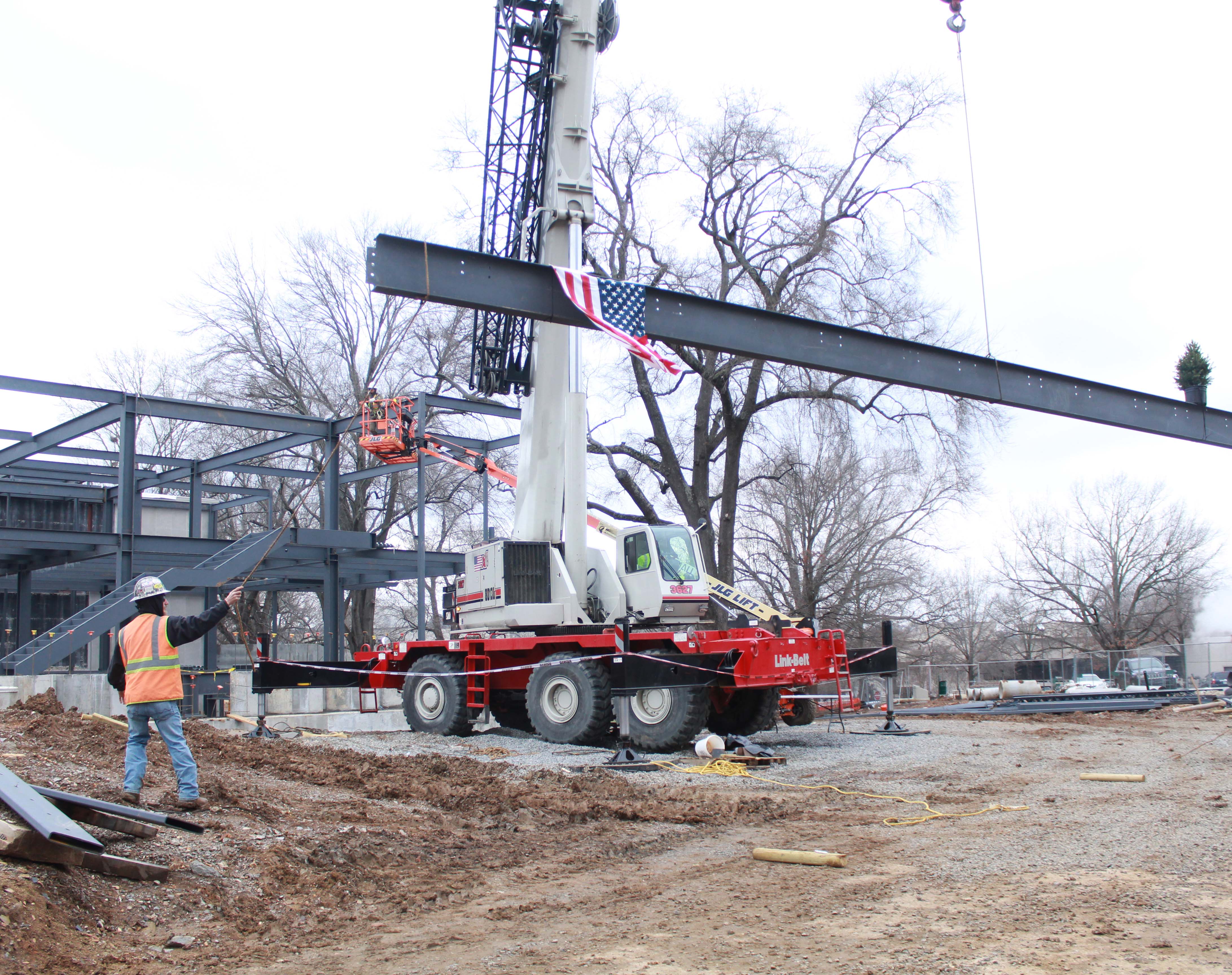Capital Crown Jewel: Supreme Court expansion on target for November
March 14-20, 2022
By Wesley Brown
Arkansas Chief Justice Dan Kemp and members of the state Supreme Court on Feb. 25 held an informal topping out ceremony for the expansion of the Justice building complex on the north side of the State Capitol.
Nearly six years ago, the Supreme Court voted to explore the possibility of two new wings to the existing 64-year-old Justice Building complex. When construction on the project began last summer, Kemp said the expansion would allow the state Administrative Office of the Court (AOC) to have all staff under one roof, instead of having personnel in three separate buildings around the city.
At the recent topping out ceremony, a beaming Kemp said the new expansion will be a centerpiece of the State Capitol grounds. The nearly $13 million project designed by Little Rock-based AMR Architects and Brackett-Krennerich and Associates of Jonesboro will expand the two north and south wings of the existing Justice Building that houses the Arkansas Supreme Court Library, the Arkansas Court of Appeals and the Administrative Office of the Courts.
“This new expansion will be the crown jewel of the Capitol complex. It will feature a mock courtroom and a Civics Education Center, where Arkansans of all ages can go to learn about the three branches of government, the importance of civility, and how our state judiciary works,” said Kemp. “The Center will be an important facility for all three branches to gather, learn from each other, and illustrate why our republic is so special.”
In addition, the ongoing expansion will allow for over 10,000 square feet of meeting space, and an additional 7,500 square feet which will serve as a Capitol Grounds Visitor and Civics Education Center. State Court Administrator Marty Sullivan said although it was not economically feasible five years ago, low interest rates and an existing bond revenue stream will allow for groundbreaking on the project to be completed in a year and a half.
“Utilizing low interest rates and an existing bond revenue stream, the Justice Building expansion will save additional expenses by allowing the AOC to place all staff at one site rather than three different buildings,” said Sullivan. “The expansion will provide new opportunities for the public to engage with the Judicial Branch, learn more about the critical role of courts in upholding justice, and serve as a welcoming center for students and adults visiting the capital.”
In explaining the new Justice Building visitors’ center, Sullivan credited his predecessor and longtime AOC Director J.D. Gingerich, who served 28 years overseeing AOC during the terms of seven chief justices of Arkansas’ highest court. Sullivan said before Gingerich retired from AOC in late 2017, he consulted on similar projects across the U.S.
“Fortunately, he was a friend of mine and I got to work for him and now I talk to him every week,” said Sullivan. “He did a lot of groundbreaking things, and I really am humbled to have learned from him and got to know him.”
Sullivan said the new Civics Education Center is styled after the Thomas J. Moyer Ohio Judicial Center in Columbus, Ohio, which includes the state courthouse, office building and library in the city’s downtown Civic Center. Named after Ohio’s former chief justice Thomas Moyer, the building is the headquarters of the Supreme Court of Ohio, as well as the Ohio Court of Claims and Ohio Judicial Conference.
As noted by Sullivan, the Ohio state judiciary complex began an extensive renovation in 2001 to restore the building and set it up to be used for the Supreme Court of Ohio. The building reopened in 2004, one year after Sullivan was hired by AOC as an intern, marking the first time the Ohio Supreme Court was established in a building solely for the judiciary, and the first time the building was open to the public.
“I got to go to that [grand] opening,” Sullivan said of the Ohio expansion project. “It was really cool, and it was geared to kids and was one of the School House Rocks exhibits. And then Michigan did it, and then Colorado and several other states.”
In overseeing the Arkansas Justice building expansion project, Sullivan said he was also inspired by the work of former Supreme Court Justice O’Connor. After retiring from the U.S. Supreme Court in 2006, Sullivan said the first woman named to the nation’s highest court became concerned about a growing lack of understanding about our system of government and the disengagement that inevitably follows.
Then in 2009, after discovering that civics education had been disappearing from curricula across the country for decades, O’Connor founded the iCivics program with the goal of transforming civic education for every student in America with innovative, truly engaging games and resources.
“It is basically a video game for kids, where they can be the judge, or they can be the juror. So, we had the idea and had to do some [financial] maneuvering but we were able to break ground on the facility last year,” said Sullivan, who has worked at AOC since 2003.
Sullivan added that the entrance to the Civics Education Center will include a quote by Justice O’ Connor. The 10,000 square feet of meeting space will also be available for use for the state’s legislative and executive branches of government, he said.
“It will truly be a Capitol grounds visitor’s center,” said Sullivan. “The ground floor there will have a model courtroom for kids, and we will have exhibits on the importance of the three branches of government and good civic dialogue. As proud as I am to have this job, I think this will probably be the biggest thing that I am a part of in my career and I am really humbled by that.”
Concerning financing for the project, Kemp and Sullivan emphasized that the Justice Building expansion is expected to open in November at no cost to Arkansas taxpayers. It will be paid for through the Administration of Justice Fund Section of the Department of Finance and Administration, Sullivan said, which collects and administers the fees, fines, and court costs that are required to be remitted by towns, cities, or counties across the state of Arkansas.
Housed within the judicial branch of government, Sullivan’s department works to support the state courts on behalf of the Arkansas Supreme Court.
The Justice Building was dedicated on June 10, 1958, and The Court Room, the round glass-enclosed wing of the building, was added later and dedicated on January 9, 1976.
The Supreme Court Justices in office when the court room was dedicated were Chief Justice Carleton Harris and Associate Justices George Rose Smith, John A. Fogleman, J. Fred Jones, Conley Byrd, J. Frank Holt and Elsijane Trimble Roy. Besides Kemp, the other six judges serving on the Arkansas Supreme Court include Associate Justices Robin Wynne, Courtney Hudson, Barbara Webb, Shawn Womack, Karen Baker and Rhonda Wood.
Before the Court Room was built, the Supreme Court held court in a temporary court room in the south end of the Justice Building. Prior to 1958 the Supreme Court Chambers and Court Room were located on the second floor of the State Capitol, which also was recently restored in 2018 and is now used by the General Assembly as a hearing room and for ceremonial functions.
Additional details about the Justice Building expansion and Capitol Grounds Visitor and Civics Education Center can be found online at https://www.arcourts.gov/content/justice-building-expansion.
Photo Caption:
1. Arkansas Justice Building expansion and Capitol Grounds Visitors and Civics Education Center on target for November
2. Arkansas Supreme Court Chief Justice Dan Kemp and Associate Justice Courtney Hudson (below) share a laugh at the topping out ceremony for the new Justice Building and Capitol Grounds Visitors and Civics Education Center. Artist renderings on the cover and inside provided by the state Administrative Office of the Courts. Photos by the Daily Record staff.



